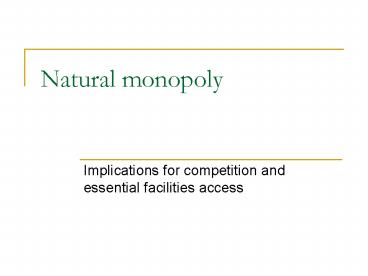Natural monopoly - PowerPoint PPT Presentation
1 / 15
Title:
Natural monopoly
Description:
The firm that offers the lowest price will win the contract. ... This is the lowest uniform price that any firm can set and not make a loss ... – PowerPoint PPT presentation
Number of Views:393
Avg rating:3.0/5.0
Title: Natural monopoly
1
Natural monopoly
- Implications for competition and essential
facilities access
2
Preliminary where have we been
3
Preliminary where are we going
4
Overview
- What is a natural monopoly?
- Natural monopolies and market conduct
- Natural monopolies and vertical production chains
- Essential facility access
- Other cases of access
5
What is a natural monopoly?
- The term natural monopoly refers to a cost
minimising technology such that, at all relevant
levels of output, it is more efficient to have
that output supplied by one firm than by more
than one firm
6
The classic natural monopoly
High fixed costs, low marginal costs, average
cost falling over relevant range of output. If
uniform pricing and PMC, firm makes a loss. To
get PMC for marginal price, need non-linear
pricing If leave to monopoly, will get monopoly
pricing Examples most utility industries
(fixed-line telephone systems, gas, water,
electricity. Towage in most Australian ports
7
Natural monopolies and markets
- The natural monopoly status of an industry
changes - as technology changes
- as demand changes
- Will a natural monopoly technology lead to a
monopoly producer? - The role of contestability
8
Standard contestability
Notes If no sunk costs and no exit or entry
barriers. If entrant can win all sales by
slightly undercutting incumbents price. If
customers can move to entrant before the
incumbent can alter price. If entrant can
costlessly leave when incumbent lowers
price. Then contestability will push price to
average cost.
9
Contestability and competition for the market
- Suppose buyers can organise so that they tender
out for a monopoly supplier. - The firm that offers the lowest price will win
the contract. - Then winning contract will set Price Average
Cost - We get the same outcome as a perfectly
contestable market - This is the lowest uniform price that any firm
can set and not make a loss - Example Port of Bunbury
10
Lessons (part 1)
- Natural monopolies MAY be fixed by the market
- But often regulation will be needed to allow
efficient production and pricing - And uniform pricing can never maximise gains from
trade need non-linear prices.
11
Natural monopoly in vertical production chains
- Suppose that a natural monopoly industry provides
an input for further production - Essential Facilities Need to pass two
essentiality tests - Are they essential inputs?
- Are there alternative outputs?
- The role of essential facilities access
- The Australian approach under Part IIIA of the
Trade Practices Act
12
Negotiated access
- Suppose an upstream natural monopoly is required
to negotiate to supply its product to a
downstream firm - What is the expected outcome if any prices can be
negotiated? - What is the expected outcome if there are
limitations on the prices being negotiated? - How will these change if the upstream natural
monopoly also competes in the downstream market?
13
Lessons (part 2)
- Negotiated pricing in a vertical production chain
with an upstream monopoly sets the likely outcome
as integrated monopoly pricing (or something
close to it and probably worse than integrated
monopoly)
14
Access to other facilities
15
Lessons (part 3)
- Before considering access to an essential
facility need to consider - Is it really essential?
- Is there a better alternative?































